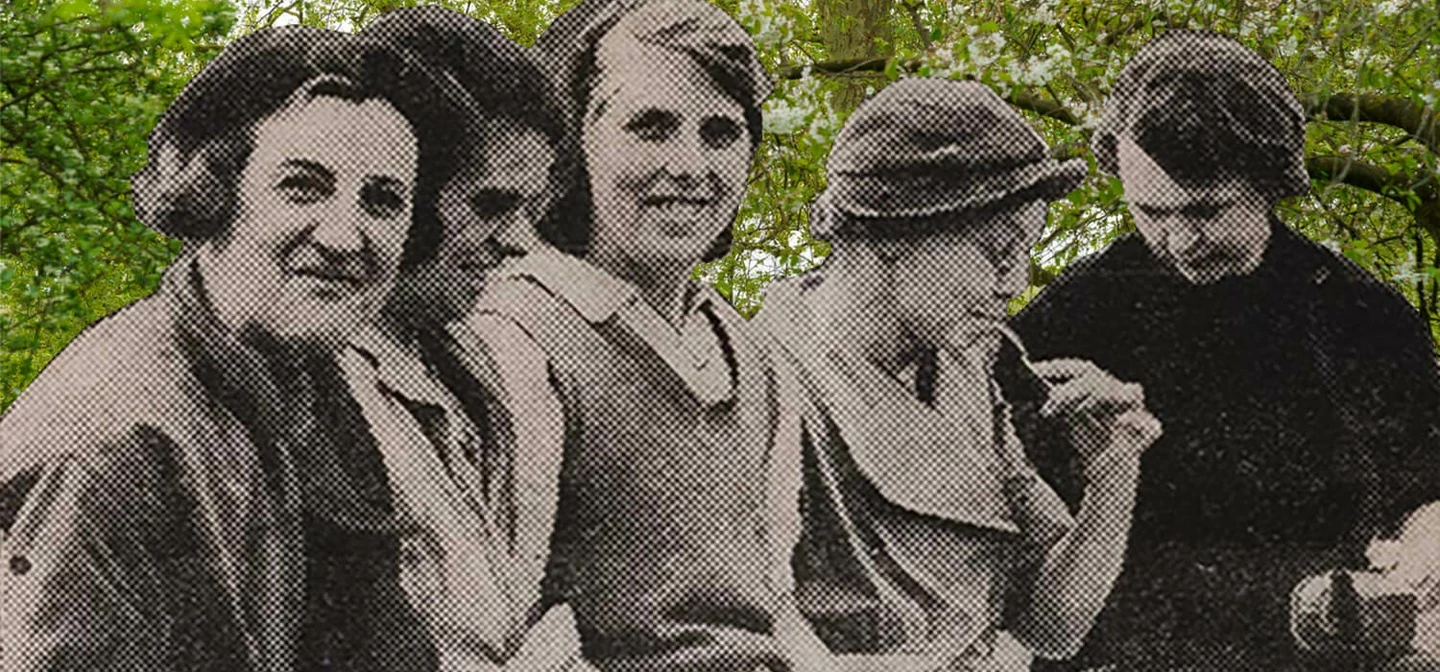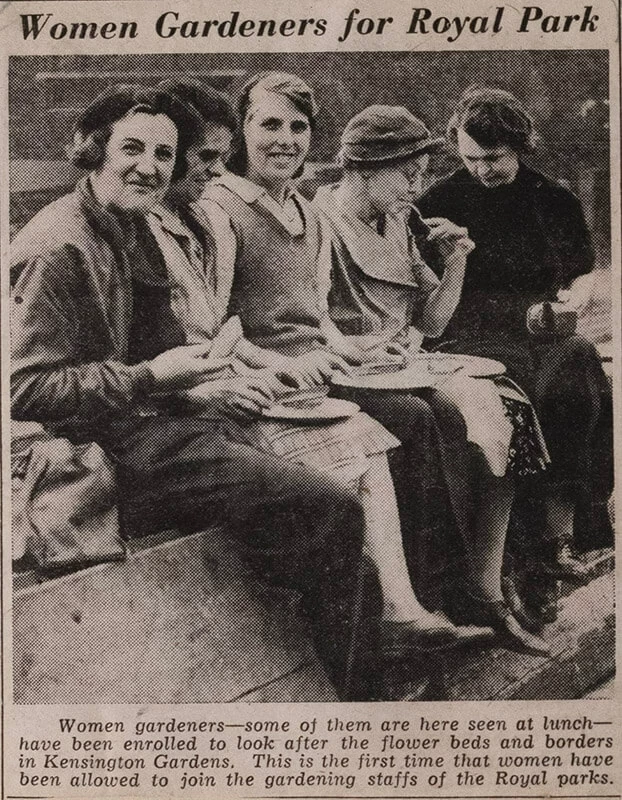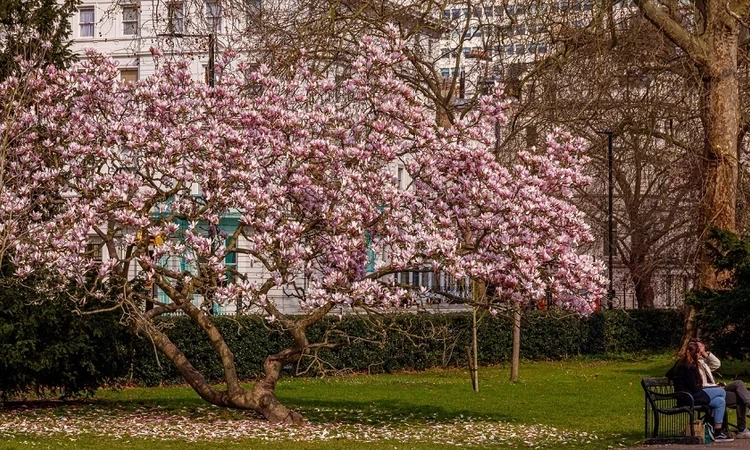
Women of The Royal Parks
This March is Women's History Month, highlighting the contributions of women and their achievements.
We’ve been delving into the archives to explore the stories of three trailblazing women who broke new ground at The Royal Parks.
This exciting new research is the result of a collaboration with David and Claire Ivison – members of The Royal Parks Guild and experts on the history of The Royal Parks.
Barbara Tarver
In July 1940, Britain was at war. In an attempt to combat food shortages, the government launched its famous ‘dig for victory’ campaign by opening a model allotment in Hyde Park where Londoners could learn to grow vegetables. The allotment was located on the edge of the Parade Ground, in an area between the Joy of Life fountain and The Grosvenor Hotel. One newspaper said it was ‘the first time Hyde Park has lent its soil to the production of carrots and onions and such-like, certainly alongside aristocratic Park Lane’.
Initially, the allotment was run by Supervisor Alfred Blye, but when he was called up for service in July 1941, an ambitious young woman took his place. Barbara Tarver was just 26 years old. A graduate of Studley Agricultural and Horticultural College for Women, Barbara went on to become one of the 50 women employed at the Royal Botanic Gardens, Kew to replace male employees who were serving in the war. At the Royal Parks, too, women had been employed to replace men who were called up – these women were the first to work as gardeners at The Royal Parks, even though their posts were only temporary.
Barbara’s new job at Hyde Park was very high profile. Following her appointment, she was introduced to the press by Mrs Hannah Hudson, the wife of the Minister of Agriculture. Her former tutor, Miss Garstan of Studley College, told the media: ‘[Barbara] is just the right person for the job. She is enthusiastic and has a sound knowledge of such work. She was a brilliant pupil and I have no doubt she will be a great success.’
Miss Garstan’s confidence was well placed – Barbara was indeed a great success. Her role of gardening advisor took her all over England, where she gave speeches and launched ‘dig for victory’ campaigns in the presence of prominent figures and famous gardeners. In March 1942, she spoke at an event in Derby, saying ‘More and more women and older children must help in this vital [war] effort, now that so many are serving in the forces.’

Women Gardeners
Later that year, Barbara was given her own weekly radio programme on the BBC’s Home Service. This five-minute slot called ‘Over the Border’ discussed weekly tips for women gardeners. One journalist quipped, ‘if most gardeners talked as much as Miss Barbara Tarver they would not get any work done at all. But she manages both, for she is in charge of the demonstration allotment… which is now a very busy spot.’ Many thousands of people visited Hyde Park to see the allotment and obtain advice on growing vegetables.
Barbara left Hyde Park in September 1942, to take up the role of assistant horticultural instructor at Midland Agricultural College, Nottinghamshire. She was not the last woman to work on the allotment, though. Her replacement was Margaret Lancaster, who had formerly been in charge of tropical plants at the Royal Botanic Gardens, Kew.
From a family of farmers near Penrith, Margaret had never thought she’d be growing crops in the middle of London. She reported her surprise at the huge crowds that flocked to the allotment – including amused American servicemen. Like Barbara, Margaret had a busy schedule of speeches and events promoting the ‘dig for victory’ campaign. She made her final appearance at a BBC panel discussion in 1944, before she was replaced by Brenda Campbell Watts – the third - and finally Miss M Armitage – the fourth – female supervisor of the allotment.
What became of the famous Barbara Tarver after the war? She continued to lecture at Midland Agricultural College until mid-1946 when she travelled to Canada to marry fellow horticulturalist Leslie Laking. He would eventually become Deputy Director of the Royal Botanic Gardens in Ontario Canada, where Barbara also worked as a much-loved lecturer in horticulture. Though Barbara died in 1986, she is still remembered at the Gardens in Ontario, where the Barbara Laking Memorial Heritage Garden was opened in 2018.

Josephine Gillespie
In honour of Women's History Month, it's worth noting that in 1956, Josephine Gillespie made history as the first female gardener employed at The Royal Parks. We recently became aware of her story after finding a press clipping in the archives – her appointment had caught the interest of a journalist, who published a feature on Josephine. With the help of The Royal Parks Guild, we were able to find Jo – now 87 years old – and ask about her memories of the parks.
The young Jo completed a two-year course in Horticulture at Studley Horticultural and Agricultural College for Women, in Warwickshire – the same institution where Barbara Tarver studied. On the completion of her studies, she moved back to her family home in London, where she worked for a brief time with a company who provided window boxes for smart offices in the capital. She interviewed for some jobs as a private gardener, but was put off when potential employers suggested she might also help with cooking and laundry. Eventually, in December 1956, Jo saw an advert for a gardening job at The Regent’s Park. Following a successful interview, she joined The Royal Parks as a gardener on 17th December 1956.
Jo knew before she started that she was the first woman to take on this role. Though women had been employed temporarily during the Second World War, no woman had worked for the parks in peacetime. When Jo was hired, the organisation was looking to diversify its workforce and she got the sense that her appointment was a bit of an ‘experiment’. It clearly went well, as other women soon joined her at The Regent’s Park. She has fond memories of her colleagues Jo, Hope, Peggy and Joan.
Jo’s day at the park began at 7am. At 8.30am, she’d get a half-hour break for breakfast. As a woman, Jo was given a separate space to take her breaks – the men sat on one side of the canteen, and Jo would sit alone in a room on the other side. Her food was delivered through a hatch, and she recalls being a little nervous on her first day when she opened it and saw crowds of men on the other side. Her fear didn’t last long, though, as all of her male colleagues were kind to her. At 11am, she’d get another 10-minute tea break followed by an hour for lunch at 1pm. Another 10-minute tea break would follow at 3pm, before the day finished at 4.45pm.


Jo started off working in the glasshouses, but soon requested to work outside too. She remembers helping to dig up trees in the middle of a heavy winter, battling the snow alongside her male colleagues. Eventually, it was agreed that female employees would work inside in the winter and outside in the summer – an arrangement that suited Jo very well.
She loved her time at The Regent’s Park and has fond memories of endless days deadheading roses in Queen Mary’s Garden and planting out the intricately arranged begonias in the nearby sunken garden – ‘the effect was stunning’, she recalls. Her favourite place was the ‘rockery’ – ‘you’d go over the little bridge and be entirely in your own world, weeding away’, she says.

Jo still remembers some of the locals she got to know at The Regent’s Park. Jo and her female colleagues nicknamed one smartly dressed regular ‘the dentist’. Another male visitor took a shine to Jo and would try to find out where she was working each day. She developed a strategy for dealing with him, waving at nearby colleagues if she needed backup. Another local wrote her a poem, which she still has displayed on her wall.

Jo left The Regent’s Park in April 1959, shortly before her marriage that summer. She now lives with her husband in a different part of the country and hasn’t been back to London for a long time – though she looks back at her years with The Royal Parks very fondly, and was delighted to hear of our interest in her story.
Jennifer Adams
In recognition of Women's History Month, Jennifer Adams is a notable woman of The Royal Parks. Though The Royal Parks employed female gardeners from 1956, it would be 27 years before a woman was appointed Park Manager. The first woman in this role was Jennifer Adams, who became Superintendent – a role equivalent to today’s Park Manager – in 1983.
Jennifer joined The Royal Parks as an apprentice in 1965, when she was 16 years old. This was just six years after Jo had become the first female gardener. By this point, Jennifer says, around a third of all apprentices were women – showing how quickly the parks had embraced the female workforce.
Like Jo, Jennifer worked at The Regent’s Park. She also recalls working in the glasshouses and the separate staff room for women – although, by the time Jennifer joined, women weren’t allowed to use the staff canteen. ‘We had a little kitchen where we could make our own food’, she recalls.
In 1970, The Royal Parks suggested that Jennifer attend the Institute of Parks and Recreation College at Pangbourne, where she obtained a Certificate of Park Management in 1971. Although she had completed the course, The Royal Parks – like many other organisations at the time – were not yet ready to give a managerial role to a female candidate. This is why Jennifer left the parks to join the London Borough of Wandsworth. Here, she eventually became Park Manager, with a staff of around 400 and a budget of £25 million.
In 1983, there was a vacancy for Superintendent of the Central Royal Parks. It had been assumed that one of the (male) Superintendents of the other Royal Parks would step up into this role, so there was some surprise when the role was given to Jennifer, an external female candidate.
As had been the case when Jo joined The Royal Parks, the press was hugely interested in the historic appointment of a women to a role that had only ever been held by men. Reporters from across the world reported on Jennifer’s new job, with particular interest being taken in the historic central parks that she looked after. More than one journalist dubbed her ‘the Queen’s gardener’. Her appointment marked an important moment in the history of women in leadership positions within The Royal Parks and continues to serve as an inspiration for women in the field of horticulture and beyond.

The Great Storm of 1987
Jennifer, now a member of The Royal Parks Guild, has very fond memories of her time in the parks. She was in post for a number of historic occasions. She met Margaret Thatcher and Nelson Mandela, enjoyed regular meetings with members of the Royal Family and played a key role in organising the funeral of Princess Diana in 1997.
Particularly memorable was the storm of 1987, when 4,500 trees were lost across the Royal Parks. While working as Superintendent, Jennifer lived in the middle of Hyde Park. During the storm, a tree fell and smashed all of her windows – she had to cut away branches in order to leave her house! Her husband’s sports car was also crushed, making the papers.
During her time at The Royal Parks, Jennifer became a leading figure in the horticultural field. She was a guest on BBC’s Women’s Hour, an Associate of Honour at the Royal Horticultural Society and President of the Institute of Horticulture. She was also granted a Lifetime Achievement Award by Horticulture Week. Queen Elizabeth II appointed her as Lieutenant of the Royal Victorian Order and she later received an OBE. These are just a few of her many achievements.
In 2001, Jennifer left The Royal Parks, taking up the post of Director of Open Spaces for the City of London. In this role, which she held until retirement, she was responsible for 10,500 acres of open space. Today, Jennifer lives outside of London where she is involved with various local groups who work on the environment, historic landscapes and nature conservation. They are very lucky to enjoy her knowledge and experience!

Related Articles
-
 Listen
ListenWomen in The Parks
In this episode, recorded for Women’s History Month, we look at some of the great women associated with the parks.
-
 Read
ReadThe suffragettes in Hyde Park
The suffragettes in Hyde Park on Women’s Sunday
-
 Read
ReadTop things to do in the Royal Parks this spring
It’s time to turn down your thermostat – spring in London is here and there’s plenty to do and enjoy in the Royal Parks.